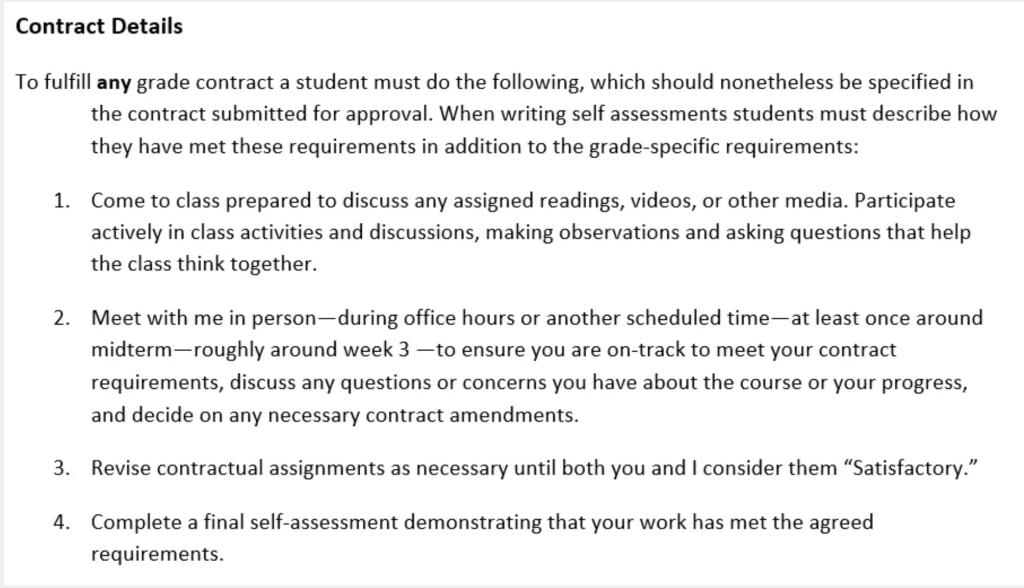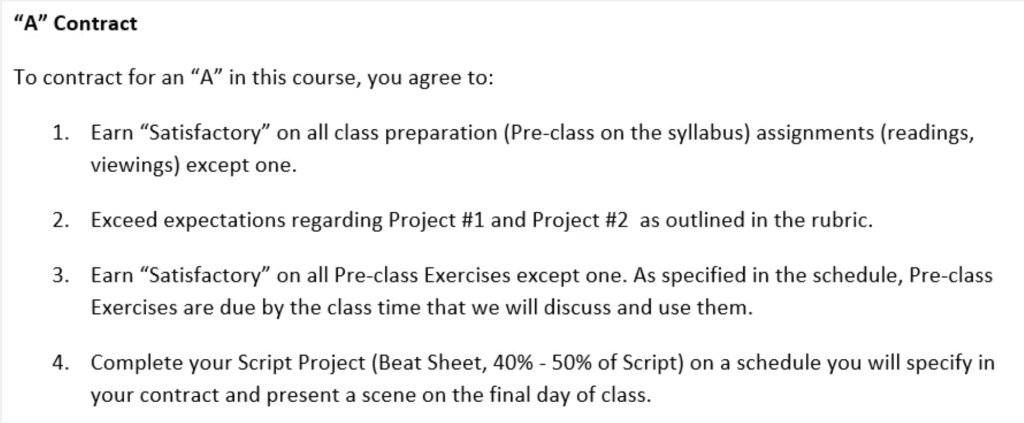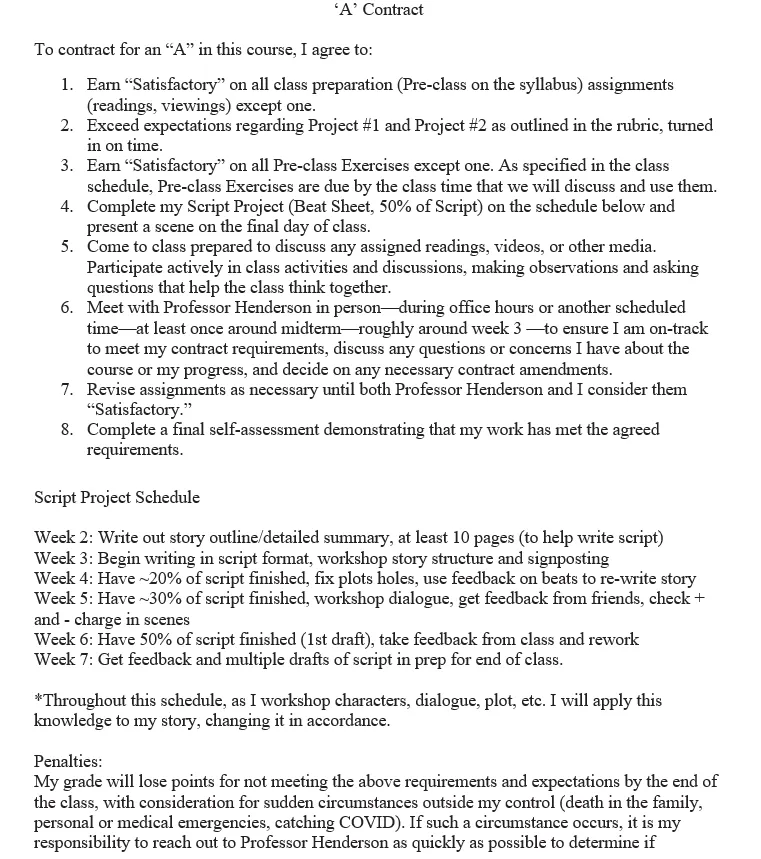Jiayue Gu, the Center for Teaching and Learning intern, interviewed Prof. Seth Henderson in May 2021 about his implementation of contract grading.

In the MEDIART 310 Screenwriting course, Professor Seth Henderson introduced an innovative grading method, contract grading, to promote student ownership and agency in learning. Contract grading is a form of grading that results from cooperation between an instructor and students and entails a contracted number of assignments of specified quality that correspond to specific letter grades. It allows each student to make the learning path for the course by giving students certain flexibility to choose the tier of requirements they want to complete and setting clear expectations in the beginning.
Why Contract Grading
Grading has been discussed a lot among professors. You may hear or have been involved in these conversations, whether grades can promote or hinder learning, and how to grade student work fairly. Henderson reflected on his turn away from conventional grading and shared the rationale of incorporating contract grading for the first time in an upper-level course.
- Contract grading could provide a way for students to be empowered to make choices for themselves of whether they would like to pursue a(n) A, B, or C grade (or D or F, in the case of failing to meet the contract agreement) for this course.
- Students are in charge of their academic learning because they need to set learning goals for themselves.
- Students have active agency not only in figuring out how to complete the assignments but also in dealing with the aftermaths of what if they could not achieve what they expected.
- Students are self-driven during the course so that they could feel rewarded for their efforts if successfully achieving their goals, or they should be prepared for penalties if they could not meet their expectations.
Henderson also quoted Cathy Davidson, a professor at CUNY, whom most of his ideas about contract grading are from:
“The advantage of contract grading is that you, the student, decide how much work you wish to do this semester; if you complete that work on time and satisfactorily, you will receive the grade for which you contracted. This means planning ahead, thinking about all of your obligations and responsibilities this semester and also determining what grade you want or need in this course. The advantage of contract grading to the professor is no whining, no special pleading, on the students part. If you complete the work you contracted for, you get the grade. Done. I respect the student who only needs a C, who has other obligations that preclude doing all of the requirements to earn an A in the course, and who contracts for the C and carries out the contract perfectly. (This is another one of those major life skills: taking responsibility for your own workflow.)”

How Contract Grading Works
Henderson adapted the contract grading guidelines from the work of Ryan Cordell and Cathy Davidson (2019). The sample “contract” shared by the professor consists of the baseline from which students can adapt. To help students get started with the contract in the first day of class, Henderson introduced and elaborated on the contract details and expectations for the A/B/C/D/F grade contract.


Then, in order to have proximal development, he encouraged students to step out of their comfort zone by guiding them to think about in what particular ways they could work on to receive a satisfactory grade. With the scaffolding from the professor, students proposed their own contracts, which were modified from the sample “contract” with concrete action items, timeline, and self-assigned penalties and rewards.
Below is the screenshot of a part of the “contract” written by one of the students in Prof. Henderson’s class.

During the course, Henderson organized small feedback groups, where students met with each other continuously and gave suggestions to peers. In the middle of the course, he reassessed students’ proposals to know how well students performed. Meanwhile, the students could adjust or change their contracts based on what they did and what they would like to modify. After the mid-term meeting and amendments, the contracts can no longer be modified, becoming the final contract. Henderson built in this flexibility to amend the contracts at the mid-point at the recommendation of Davidson and Cordell. He sees this as similar to the minor adjustments that instructors make for each course that they teach.

What Students Said
All 15 students in the class commented that the contract grading empowered them in learning because they had the agency in setting up learning goals for themselves in order to make effort to have academic achievements. Also, they regarded the contract grading as a fun challenge because they enjoyed the hardworking process of meeting the requirements set up by themselves. Notably, every student proposed an A contract (although some fell to a B in the end) and two students exceeded an A contract in terms of the quality of the work.
Challenges
With this first trial in an upper-level course in Media Arts, Henderson reflected on this experience and shared a few challenges in implementation.
- Time spent at the beginning of the course was a little bit more than usual because the instructor needs to meet with students individually to discuss their contracts and make sure they have appropriate learning goals.
- Not sure whether the contract grading could be adaptable to 100-level or introductory level courses because the instructor needs to think about whether the workload is reasonable for first-year students and whether the expectations are set correctly for incoming students.
- Contract grading demands students with a higher level of maturity because students have to be self-disciplined in order to achieve their learning goals.
- Some people who have not tried contract grading may be skeptical because it does not generally produce a bell-shaped grade curve. However, Henderson feels that part of the goal of a teacher is to get most students to a high standard, and not to strive to adhere to a prescribed grade distribution. He found that contract grading can inspire a great number of students by empowering them to take control of their studies.


